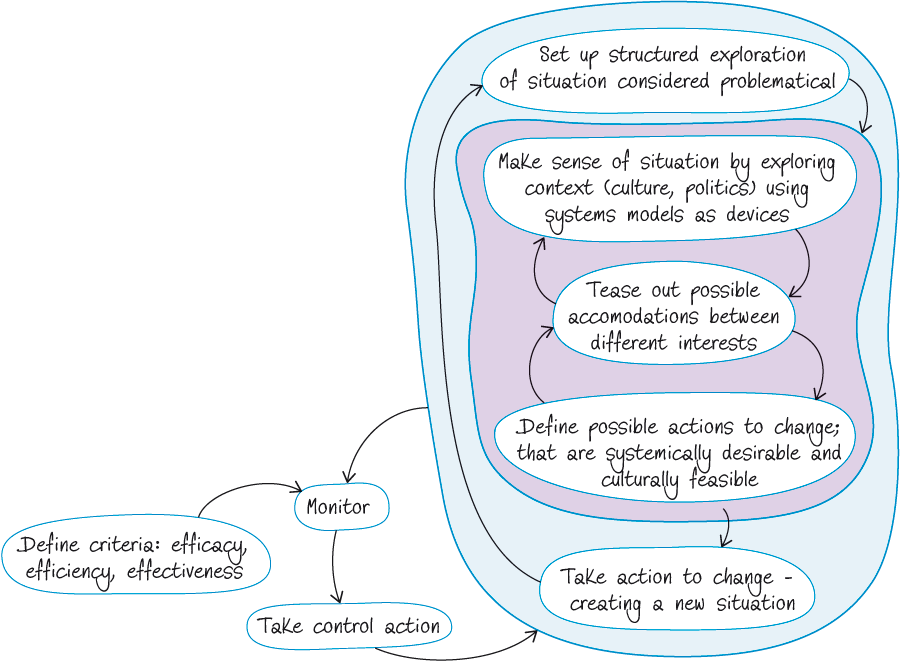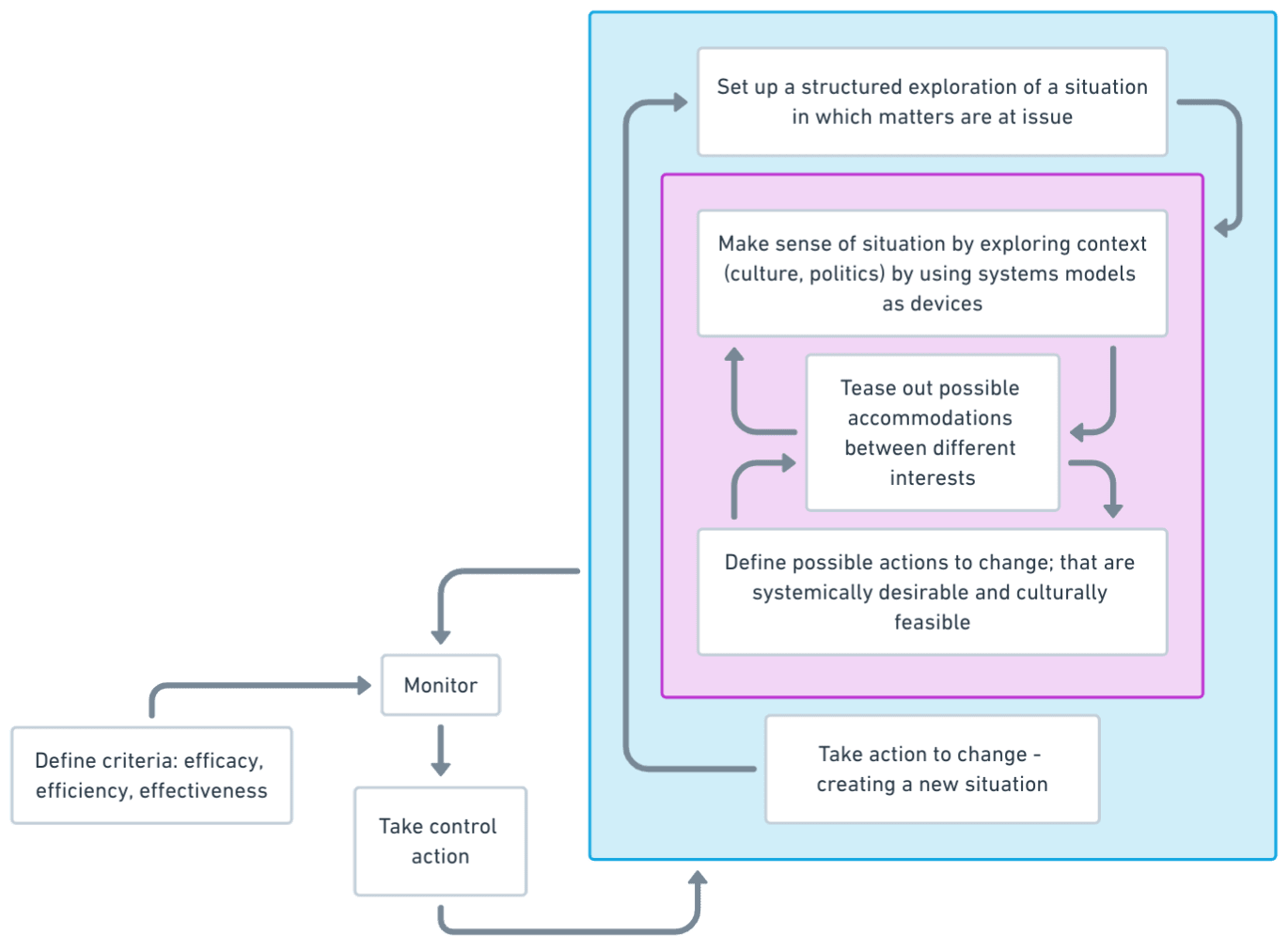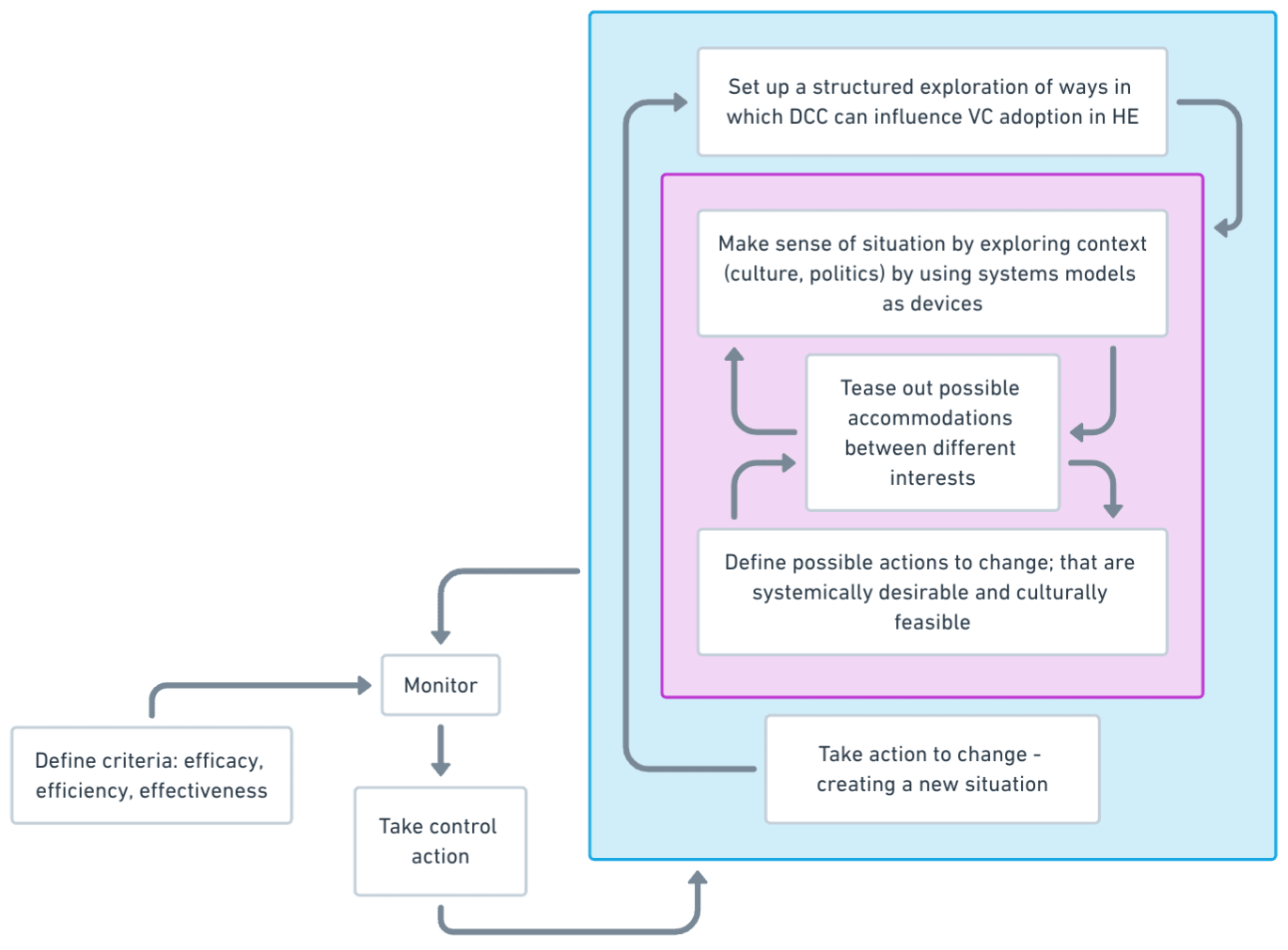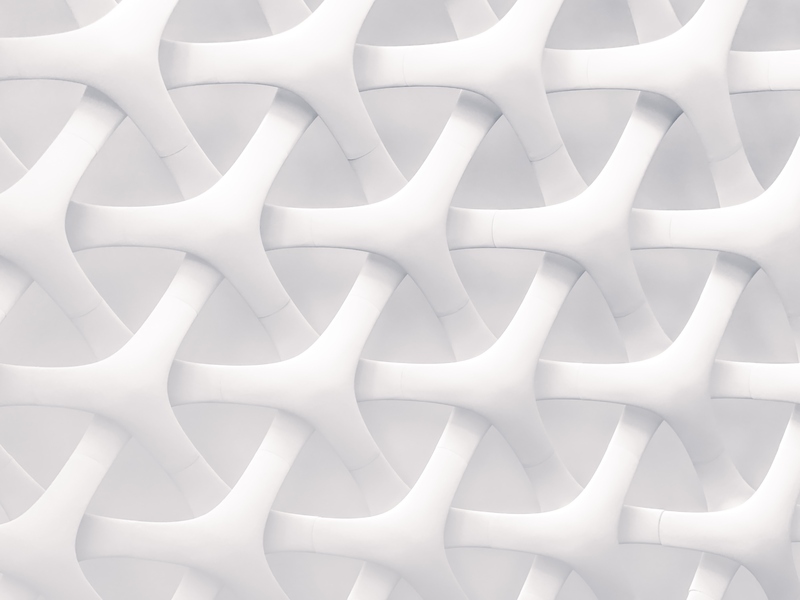TB872: Understanding systemic inquiry in activity model terms
Note: this is a post reflecting on one of the modules of my MSc in Systems Thinking in Practice. You can see all of the related posts in this category.

I’m now in Week 7 of TB872 and, although this MSc has so far taken up more time than I expected, this was the first week in which I actually became ‘stuck’. Thankfully, the student forums have fellow postgraduates with large brains who not only grappling with the same things as me, but are very helpful. So thanks to David Stead and Diana Dimitrova for giving me a hand when I went off on an incorrect tangent!
The above diagram comes from the course materials and is based on one created by Peter Checkland, the primary developer of Soft Systems Methodology (SSM):
Soft systems methodology (SSM) is an organised way of thinking that’s applicable to problematic social situations and in the management of change by using action.
[…]
The method was derived from numerous earlier systems engineering processes, primarily from the fact traditional ‘hard’ systems thinking was not able to account for larger organisational issues, with many complex relationships. SSM has a primary use in the analysis of these complex situations, where there are divergent views about the definition of the problem.
(Wikipedia)
Although the language used is always that it might be beneficial to study TB871 before TB872, it’s not required. I feel like this is a situation when it would really help. In fact, if you’re reading this and thinking about doing this MSc, I’d highly recommend that you study TB871 (which starts in May) first. My mistake was thinking in terms of traditional academic years. This course is quite different from what I’ve experienced previously — it doesn’t stop for Christmas! 😮
As this is the first time I’ve come across SSM, unlike those who have studied TB871, I haven’t come across the acronym CATWOE. The course materials say not to worry if this is the case, but I want to learn about this stuff. The Wikipedia definition is a bit wordy so I turned to the GPT I created for this course:
CATWOE is an acronym used in Soft Systems Methodology (SSM), a tool for problem structuring in complex systems. Each letter in CATWOE represents a different element to consider when understanding and articulating problems and solutions in a system. The elements are:
- C – Customers: These are the beneficiaries or victims of the system. They are the individuals or groups who are affected by the outcomes of the system.
- A – Actors: These are the people who are involved in carrying out the activities within the system. They are the individuals or groups who actually perform the tasks or processes that the system entails.
- T – Transformation Process: This represents the conversion of inputs into outputs by the system. It is the core process or set of activities that the system performs to achieve its objectives.
- W – Weltanschauung (Worldview): This refers to the wider worldviews or belief systems that justify the existence of the system. It’s the set of assumptions, cultural values, and beliefs that frame how the system is viewed and understood.
- O – Owners: These are the individuals or groups who have the power to change or shut down the system. They have control over the system and can make significant decisions about its operation.
- E – Environmental Constraints: These are the external elements that can influence or limit the system. They include legal, ethical, social, and physical environmental factors that the system must operate within.
CATWOE helps in creating rich pictures of complex situations and in defining root definitions of systems in SSM, thereby aiding in the understanding and analysis of complex problems in a structured way.
My understanding is therefore that this is a way that you don’t miss anything out when designing a systemic inquiry.
Ray Ison, the course author for this section, says that his “inclination” is to replace the words at the top of Checkland’s SSM diagram with “set up a structured exploration of a situation in which matters are at issue”. This is because not everyone sees a situation in the same way: for example, you might see it as ‘problematical’ whereas others might not. Equally, it may be useful to frame the system in terms of ‘opportunities’.
So I’ve replicated the original diagram in Whimsical, replacing ‘situation considered problematical’ with ‘situation in which matters are at issue’. I’ll come back and update this as my systemic inquiry progresses.

There are a number of situations or issues which could be considered a ‘contested opportunity’ and which are of concern to me. There are some ones in my personal life, for example; there are also some internal to WAO. But I think the one I want to focus on, as I mentioned in my learning contract, is the work we’ve just started with the DCC around the adoption of their technology to promote Verifiable Credentials (VCs) in Higher Education (HE).
This part of the course is meant to be a virtuous cycle of inquiry where understanding my own practice (S1) allows me to apply what I’ve learned in a situation of concern (S2). I’m going to use CATWOE for the first time, so I might not use it appropriately. Here goes:
- Customers (C): Primary beneficiaries are HE institutions and students who will use VCs. This also extends to employers and other organisations that rely on the authenticity of academic credentials. It may also include vendors such as online learning providers who use the standards and reference implementations that the DCC have worked on and helped develop.
- Actors (A): DCC staff along with WAO members and collaborators, who work with: Registrars and IT staff at the HE institutions, vendors, educators, administrators, and students. I’m a little fuzzy about this one, as it could involve, well, lots of people .
- Transformation Process (T): The transformation process is the adoption and integration of VCs at HE institutions. This involves shifting from traditional credentialing systems to a digital system, which includes logistical changes such as verification processes, documentation, and communication.
- Weltanschauung (Worldview) (W): There is an underlying belief that VCs increase transparency, efficiency, and the authenticity of academic qualifications. This is in alignment with the broader digital transformation of HE as well as a move towards more learner agency and user control of data. It also fits in with a perhaps less-articulated view that HE institutions are moving towards issuing many more credentials than in the past, and need to do so in a way that preserves their reputation, works for employers, and is understandable by students.
- Owners (O): Decision-makers and stakeholders with the power to implement and modify the VC ecosystem are many and varied, including the W3C working group. However, for this project, the ‘owners’ are DCC staff who have control over their software, Registrars who can start and shut down projects, as well as IT departments who can veto work on tech projects which are too problematic. In fact, the owners are almost all actors, with the exception perhaps of students and vendors? I need to think more about this.
- Environmental Constraints (E): These have been well thought through given data privacy and security requirements and technological constraints (e.g. interoperability with existing systems). One thing to consider is the attitude, readiness, and acceptance of stakeholders (e.g. registrars, IT staff, students, employers) for VCs.
We’ll be running a workshop in the new year to discuss this with DCC staff as we’ve noticed a slightly (but important!) difference between how they talk about influencing the system and how the reports they have produced discuss it. We want to explore that further.
To reflect Ison’s difference from Checkland in terms of a ‘situation considered problematical’ compared to a ‘situation in which matters are at issue’, I’m viewing this through the lens of opportunity. That is to say that I, personally (and I think other people involved in this work) see VCs as going well beyond merely replacing paper transcripts with their digital equivalent. This is why I’ve been so interested in Open Badges for over a decade.
When I was teaching, a popular way of talking about the introduction of educational technology was Ruben Puentedura’s SAMR model. It’s an easy way to show that technologies can be used to substitute, augment, modify, or redefine what’s gone before.

So, although VCs and data wallets might sound a little boring when simply applied to transcripts, things become a little more exciting when we start thinking about a much more holistic way of representing our learning. For example, instead of me simply receiving an MSc at the end of three years for this course, I could receive some for the way that I interact on student forums, for the grades that I get along the way, and even for these blog posts.
It’s worth thinking about how I would judge improvement in the situation of concern compared to others. I think that staff at the DCC would like to see much more widespread adoption. This is likely to include an increase in the number of partner institutions, and I’m assuming a preference for more prestigious universities which would be in alignment with MIT, which is where the DCC is hosted.
Based on our early work, I think that staff in HE institutions (e.g. registrars and IT staff) would judge improvement if other organisations they know and respect are using VCs successfully. I assume that they would also judge things to be improving if vendors they already work with (e.g. for student information systems) offer VCs as something they can integrate seamlessly.
Personally I would judge improvement in the situation of concern in three ways:
- DCC staff, with the help of WAO, come up with a compelling way of describing VCs and their use cases, leading to greater interest in the W3C standard and DCC’s reference technologies.
- More institutions request to join the DCC, making more money and influence available to advocate for the use of VCs in HE.
- HE institutions start issuing VCs at scale for a range of purposes, including both credit-bearing and non-credit-bearing purposes.
One thing I haven’t discussed so far is culture and power. As anyone who has been around HE institutions will be aware, these are almost the definition of stratified organisations with hierarchical roles and power. What isn’t referenced on the SSM diagram, but which is well worth thinking about is influence. There are ways of cutting through institutional bureaucracy by the right people (DCC) providing the right solution (VCs) at the right time (hopefully now!)
As I’ve already hinted, I’m fully invested in the digital and alternative credentials ecosystem. I’m sat here studying for my fourth postgraduate qualification, so I obviously find value in the kind of education and credentialling that HE institutions provide. However, I don’t think it’s enough. Nor do I think that merely issuing VCs for high-stakes credentials such as degrees is enough.
In the past I’ve been possibly a little antagonistic and gadfly-ish in relation to HE staff and institutions. However, this work is an opportunity to really think systemically about introducing change which could impact, eventually, upon millions of people. At ePIC, for example, I went to a presentation which talked about the University of Lyon‘s use of blockchain-based credentials and how this had absolutely transformed the life of one man in Africa, who was having to pay $30 every time he applied for a job to have made a certified copy of his degree certificate.
10 years ago, when I had a bit of an argument with Mitch Resnick about extrinsic motivation and badges, I think it was easy for HE institutions to dismiss digital credentials. These days, however, and particularly in these pandemic times, it’s much easier for them to reconceptualise them as ‘microcredentials’ as see them as a business opportunity. This is particularly important as HE becomes more of a marketplace and more consumer-oriented than it ever has been before.
Finally, then, let’s return to the SSM diagram and tweak it a little:

This might seem like a lot of words to have simply replaced the words at the top of the diagram, but working through this has given me a (slightly) clearer picture of what I need to do next. For example, if I apply the PFMS heuristic to the situation I’ll be able to start seeing the different frameworks and methods that other practitioners involved bring to bear on the situation.



